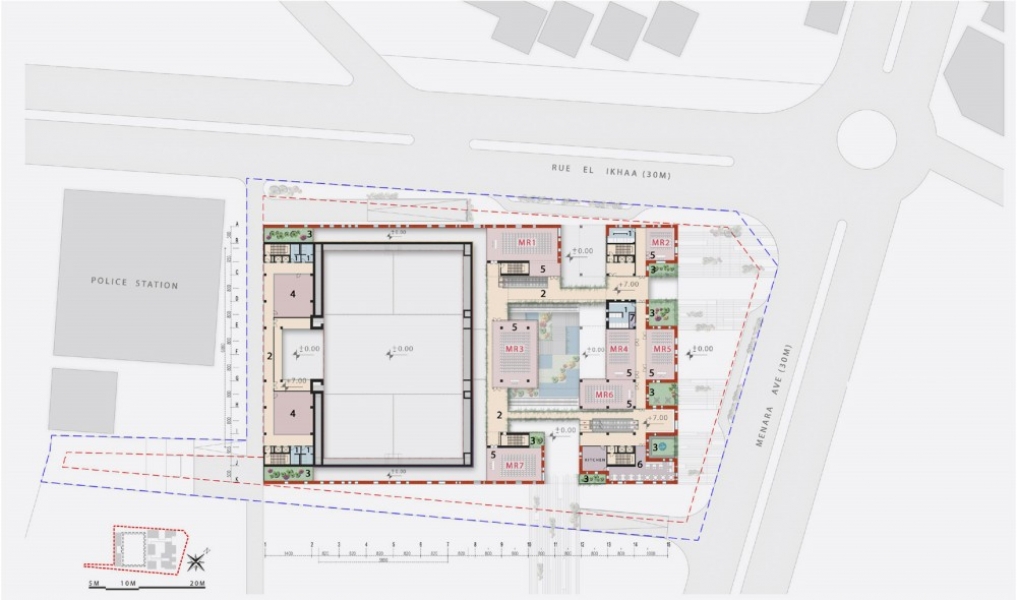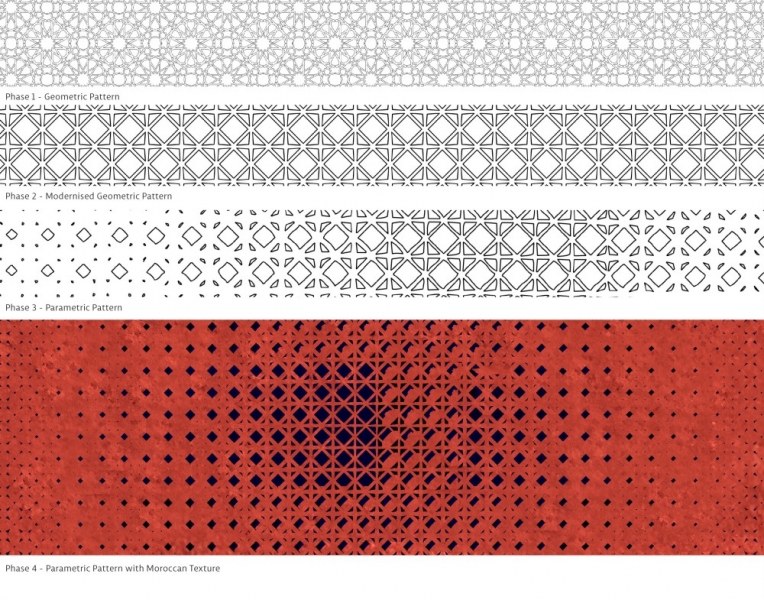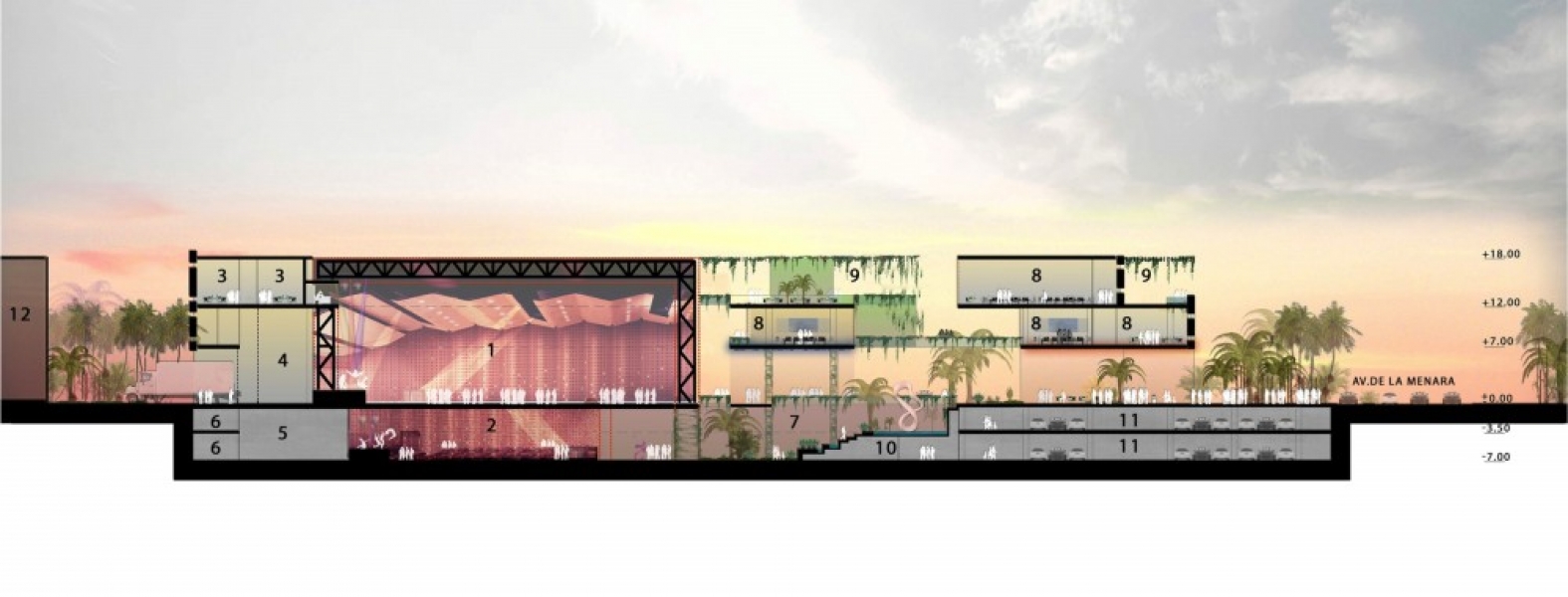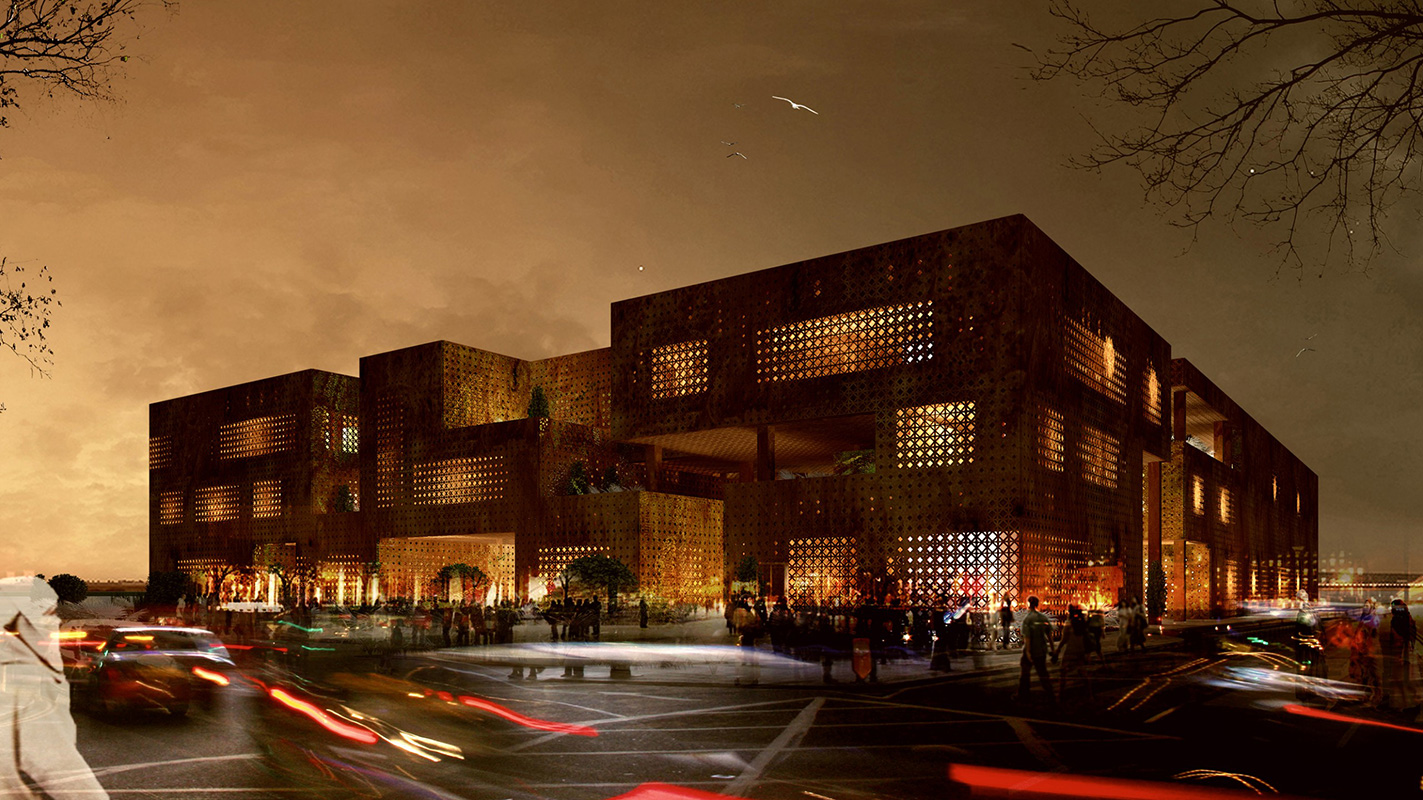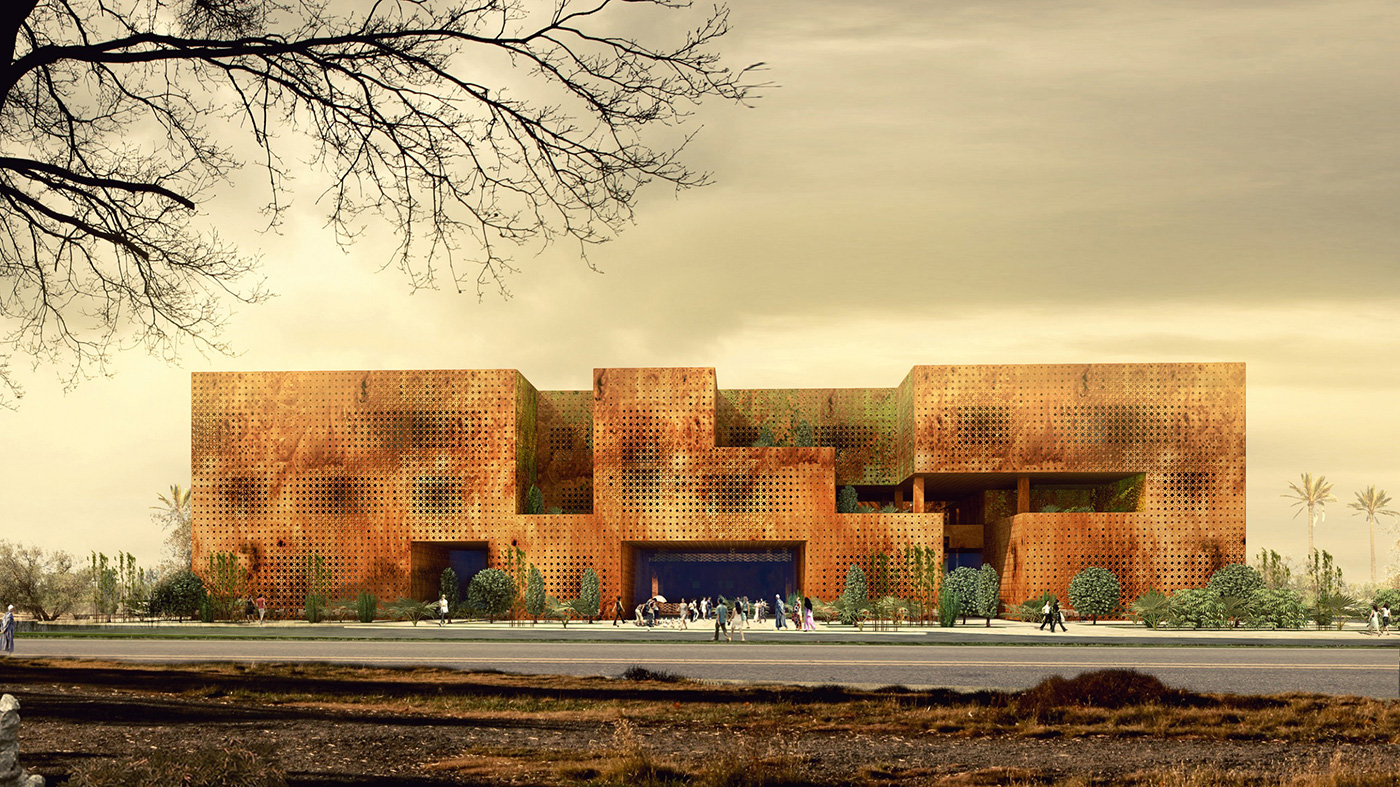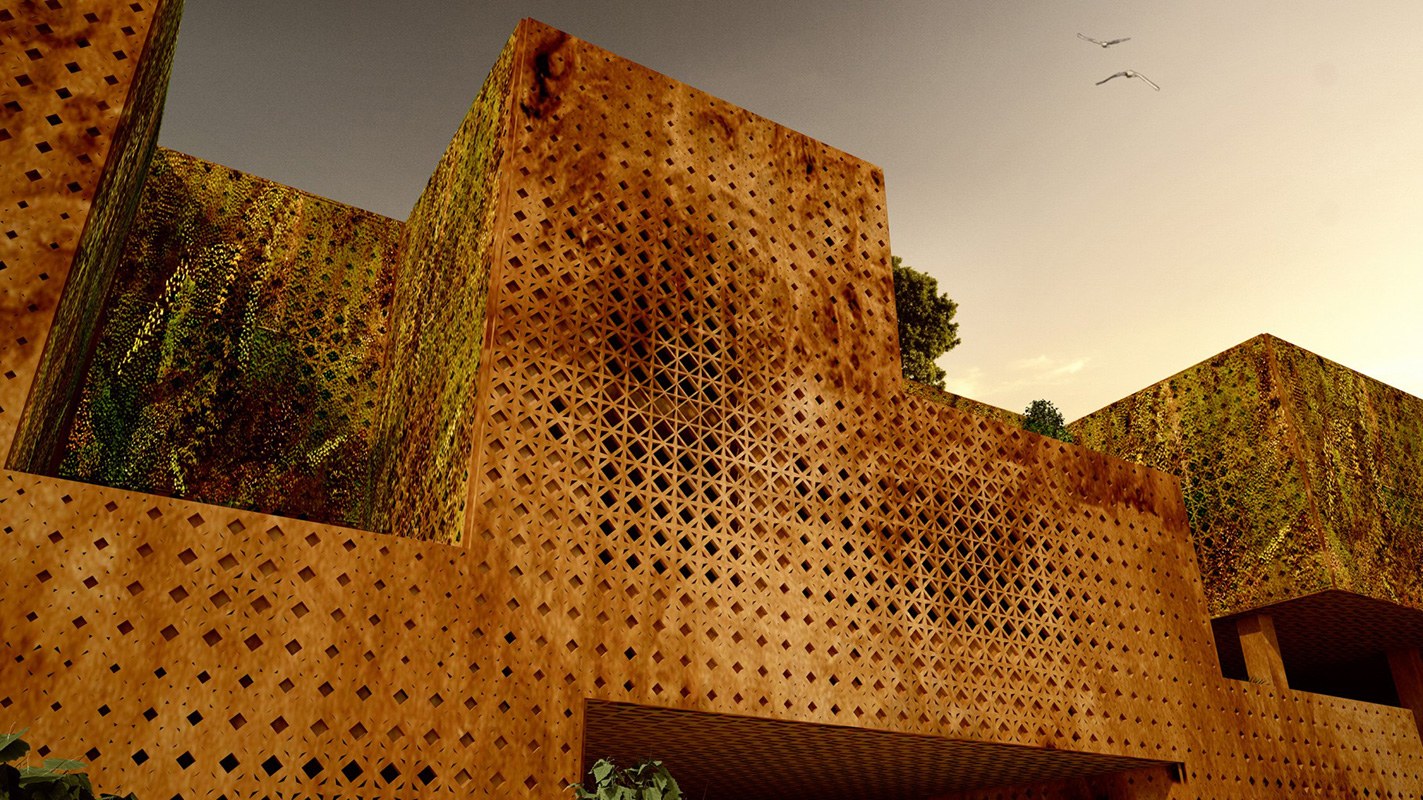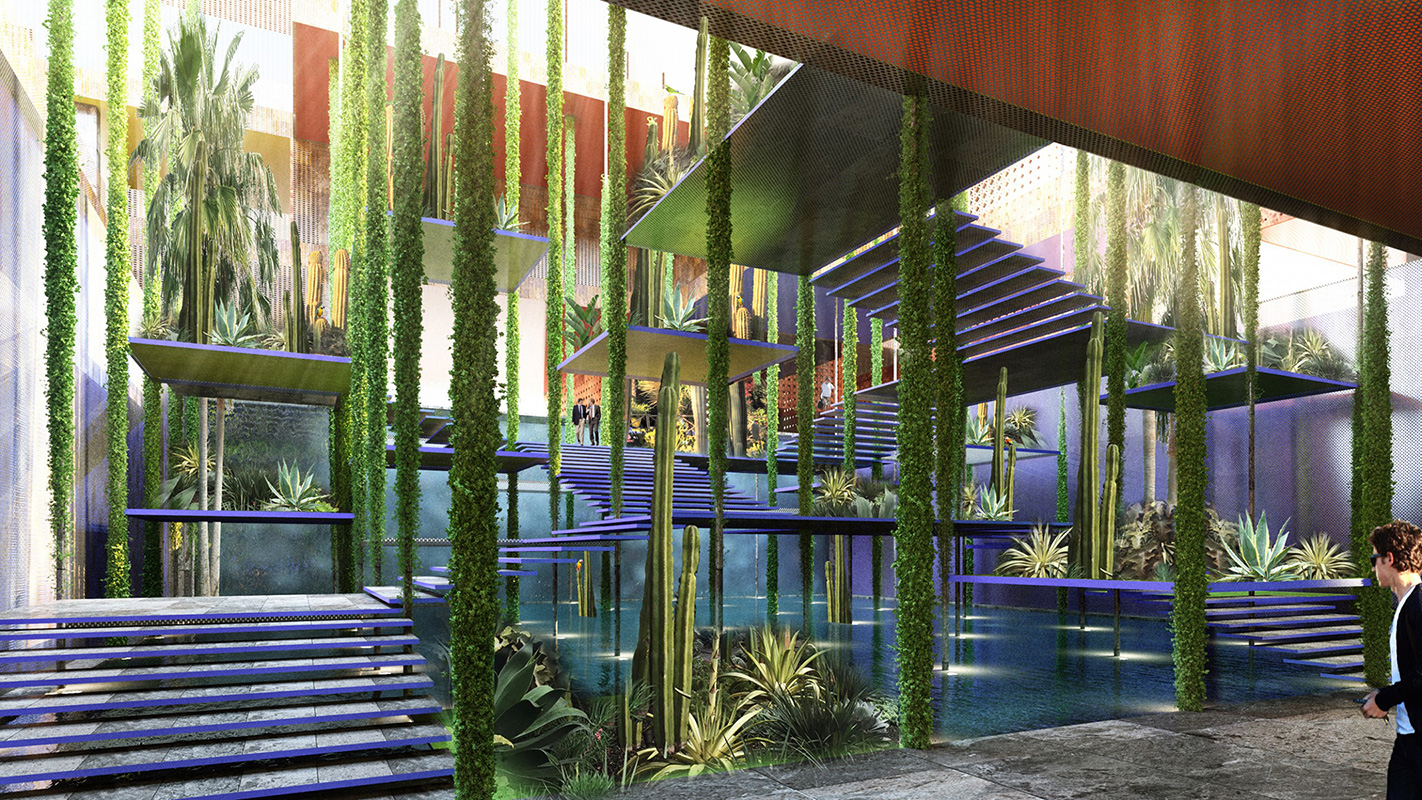-
Tabanlioglu Architects Releases Plans for Marrakech Congress Center
Architects:
Tabanlıoğlu Architects
Location: Marrakech,
Morocco
Project Team: Melkan Gürsel & Murat Tabanlioglu, Salih Yılgörür, Ali Çalışkan, Utkan Yönter, Erman Uçaroğlu, Ece çakır
Interior Décor: Tabanlioglu Architects
Project Year: 2025
Photographer: Tabanlioglu Architects
Website: www.tabanlioglu.com
Area: 14,000sqm
-
- 07 July 2016

- Datum Editorial
- Centres , Communal Centres , Cultural Centres , Selected Works , Editor's Choice ,
Tabanlioglu Architects have released plans for the new Marrakech Congress Centre in Morocco in a design that continues with the firm's tradition of pattern based architecture. The design follows an authentic ideology of incorporating culture and identity into the busy city, southwest of Rabat. Living Culture Marrakesh is a major city of Morocco. It is the fourth largest city in the country, after Casablanca, Fes and Tangier. It is the capital city of the mid-southwestern region of Marrakesh-Asfi. Located to the north of the foothills of the snow-capped Atlas Mountains, Marrakesh is located southwest of Tangier, southwest of the Moroccan capital of Rabat, and south of Casablanca. Marrakesh is one of Morocco's four former imperial cities that were built by Moroccan Berber empires.

The region has been inhabited by Berber farmers since Neolithic times, but the actual city was founded in 1062. Madrasas (Koranic schools) and mosques built under Andalusian influences in the 12th century. The red walls of the city and various buildings constructed in red sandstone during this period, have given the city the nickname of the "Red City" or "Ochre City". Like many Moroccan cities, Marrakesh comprises an old fortified city packed with vendors and their stalls (the medina), bordered by modern neighborhoods. Marrakesh grew rapidly and established itself as a cultural, religious, and trading center for the Maghreb and sub-Saharan Africa. Today it is one of the busiest cities in Africa and serves as a major economic center and tourist destination.

From The Architects
Respecting site’s history and texture, the congress center preserves essence of local values in terms of material use, patterns, colors and use of space. The project, basically housing a main conference hall, emerges from the inside out, and becomes a sheltered place of uniting international representations. Strong in/out relation provided by transparency, integrated spaces and through inner gardens and patios.

Reference values of living culture and vernacular tradition, grants building ability to make the user think and feel in local ambiance.The robust looking structure enveloped by a natural stone facade articulated with perforations that allow diffused light to fill interiors; endless geometric patterns like mandala unifies the shell.

During different hours of day, light shifts and plays across interior spaces and gardens creating a serene and natural environment, and imbues a hue while granting natural climate control system. Indentations create gardens at upper levels and form unique modules, so spaces distinguished from outside.

Dynamic interior flow is initiated with the landscaped inner patio/atrium on the ground floor which is visible since the entrance of the building which is made through porticos, the middle one being the sublime port that is also a reference to striking local doors of Morocco.
Sipopo Congress Center / Tabanlıoğlu Architects
Located in the coastal curve of West Africa, Equatorial Guinea includes several small offshore islands and an insular region containing Annobon and Bioko islands. Malabo is the capital and the second largest city of Equatorial Guinea, located on the northern coast of Bioko Island.
SHARE YOUR THOUGHTS
-
If you want your own avatar and keep track of your discussions with the community, sign up to archiDATUM >>
SELECTED WORKS
-

- British Council, Freetown / Manser Practice
- 12 Nov 2015
The British Council is perhaps the biggest export of architectural heritage across the world, comparable only in second place to the Dutc...
-

This house has been designed to be highly flexible and adapt to the owners' changing needs. The house has two skins throughout: the slidi...
-

- Congo Kintele Congress Centre / AVCI Architects
- 12 Sep 2017
The new Kintele Congress Centre and Resort Hotel (KCC) is in a newly developing area of Brazzaville, to the north of the new Olympic Cent...
CONTEMPORARY AFRICAN DIRECTORY
-
- Kituo Cha Sheria/ Morphosis Architects
- 06 Jan 2015
Few competitions evoke a sense of a well thought out process like the Kituo cha sharia completion undertaken by Morphosis LTD architects....
-

- Makoko Floating School/ NLÉ
- 19 Mar 2015
The Makoko Floating School is movable 'building' or 'watercraft' currently located in the aquatic community of Makoko. It is a floating s...
-

- Rosebank Lofts / 26’10 South Architects
- 18 Nov 2015
"At an initial briefing we were told to create the “loft from hell”. Hell being a place of total decadence and indulgence. Our job can th...
ARCHIDATUM BROWSER
-
-
-
category
Africana Apartments archiDATUM Audio ArchiDATUM Dates archiDATUM Jobs archiDATUM News archiDATUM Talks ArchitectsArchitects + Spaces Architecture Art Articles Books & Magazines Books & Magazines Centres City Planning CommercialCommercial Centres Communal Centres Competitions Conservation Conservation Architecture Contemporary Contemporary African Directory Editor's ChoiceEducation Centres Events Faculty Years Financial Gated Communities Health Centres Hotels Human AnatomyTechnology Traditional Training Transit Oriented Urban Urban Architecture Videos Weekly Round Up: Architecture in AfricaTaxi Ranks Obituary African Greats Concept Store Lifestyle Luxury Stores African Modernity Ideas of InterestAfrican Modernism Pritzker Prize Makers of a Continent Spotlight Pancho Guedes Pin Up Architectural Photography LensSwahili Architecture Contemporary Swahili Women In Architecture Parliaments Exhibition Houses ArchiDiaries Great City Terrible Place -
POPULAR
Datum Antique: Sasaki Associates’ Green Lung of... Falatow Jigisayo Orphanage / F8 Architecture + ... Mapungubwe Interpretation Centre / Peter Rich A...Eko Atlantic City / AR+H Architects House 12 Magnolia Hills / Mehraz Ehsani Msafiri Mwazighe And The White Fields Of Sustai... International Conference Center / CAAU ArchitectsCentre de Santé et de Promotion Sociale/ Kéré A... Dennis Mukuba And The Unbowed Hues of Justice: ... Dakar's International Conference Center / Taban... TechU Ibadan campus / MZ ArchitectsTena Tower-Tena Lakes/ Manuelle Gautrand Nigerian Cultural Centre and Millenium Tower / ... 10 Greenest Buildings in Africa AFGRI Headquarters Office Building/ Paragon Arc...Halawa House / Abdel Wahed El-Wakil Bibliotheca Alexandrina / Snøhetta Mankgaile Limpopo Primary School/ SAOTA Tripoli Convention Centre/ Tabanlıoğlu ArchitectsLagos State Considers ‘Makoko Floating School’ ... Marrakech-Menara Airport Extension/ E2A Archite... US Embassy Maputo/ Allied Works Architecture Dar es Salaam: An Emerging African MetropolisBlock 36, Westown / Shahira H. Fahmy Architects Grand Théatre de Rabat / Zaha Hadid Architects ZHA ArchiDATUM Dates: Issa Diabaté on a Political A... English Point Marina/ Broadway Malyan ArchitectsLibyan European Hospital /Carlo Berarducci Arch... Glover 57 Apartments / Domaine Public Architects National Park of Mali / Kere Architecture George Yagomba And A Sail Across Diplomacy: Par...Botswana Innovation Hub/ SHoP Architects Mayotte Airport / REC Architecture Goma Catholic Cathedral/ Lexicon + Ion Architects National Theater of Equatorial Guinea / Indepen...Mopti Centre For Earth Architecture / Kere Arch... ArchiDATUM Dates: SAOTA's Greg Truen On Modern ... Kwame Nkrumah Presidential Library/ Mario Cucin... Why Abandon The Mud Hut: Joe Osae-Addo and affi...Universidade Agostinho Neto / Perkins + Will Ar... The CAD Enigma: The Backlash Within Architectur... Windmills Chapel / Koop Design Don Bosco Catholic Church/ Space and Systems Ar...The Technology School of Guelmim/ Saad El Kabb... Sinthian Thread Arts Cultural Centre / Toshiko ... Concrete Beauty: Towards an Architectural Language KE Ochieng/SAOTACollege Ouangani, Mayotte/ TERRENEUVE architects Sipopo Congress Center / Tabanlıoğlu Architects Casa Port Railway Station/ AREP Karura Forest Environmental Education Centre / ...Umubano Primary School/ MASS Design Great City Terrible Place: Future of Island Cities Alexandra Interpretation Centre / Peter Rich Ar... Benga Riverside Residential Community / Kere Ar...Warka Water/ Architecture and Vision - Arturo V... Glass House/ Nico Van Der Meulen Architects South African Embassy, Addis Ababa/ MMA Design ... Blair Atholl House / Nico Van Der Meulen Archit...Opera Village Laongo/ Kéré Architecture Aloe Ridge House/ Metropole Architects Controversy Sells: In Defence of the One Finger... Gando Primary School / Kéré ArchitectureCalabar International Conference Center/ Hennin... Classrooms for University of Namibia/ Wasserfal... Head Office Ernst & Young / Wasserfall Munting ... Aveni-Re Building/ Koffi & Diabaté ArchitectesBMCE Branches / Foster + Partners Architecture of African Origin: Beyond the Dist... Kigali: A City’s Rebirth Into The 21st Century Constantine Exhibition Centre / PTW ArchitectsNIB Mixed Use / Xavier Vilalta Architects Ahmed Baba Institute of Higher Islamic Studies ... The Boma Hotel/ Morphosis Architects Soweto Theatre / AfritectsHouse Serengeti/Nico van der Meulen Dedan Kimathi Monument/ School of Fine Art, Ken... Kituo Cha Sheria/ Morphosis Architects FOCHTA Vocational Training Centre/Sam Crawford ...Baragwanath Transport Interchange and Traders M... Equatorial Guinea Ministry of Mines, Industry a... Butaro Doctor’s Housing/ MASS Design Group Ardhi University/ University of Dar es SalaamAbdel Wahed El-Wakil / The Benefits of Traditio... New British High Commission / Kilburn Nightinga... The Mauritius Commercial Bank Ebene / Jean Fran... Central Catering Unit/ Dalgliesh Marshall JohnsonTaroudant University / Saad El Kabbaj, Driss Ke... Ouagadougou International Airport / ENIA Archi... Rabat-Salé Urban Infrastructure Project, Hassan... New Rugo Social Housing / George Pericles Archi...Africa Needs Glass Architecture; Or Does It? 30 Jellicoe Avenue/ Paragon Architects El Gouna Hotel Resort / Michael Seagraves Archi... OVD 919/ SAOTAArchitecture Of African Origin (AOAO): Isn’t th... Villagio Vista / Allford Hall Monaghan Morris Great Mosque of Touba / Tashiko Mori Riviera Apartments / Domaine Public ArchitectsModern House: Slow Death of African Informal Se... The Teodoro Obiang Nguema Mbasogo Presidential ... Adeline Gruber on Translating the Man Made : An... Rwinkwavu Neonatal Intensive Care Unit / Mass D...Durban Beach Front Redevelopment / Design Works... Cove 3 – Pezula Knysna/ SAOTA French School Group Jean Mermoz / Terreneuve A... Film + Architecture: What it Holds for AfricaThe Taita Sustainable Vernacular House Mama Sarah Foundation School/Kere Architecture Butaro Hospital/ MASS Design Group Long Beach Resort / Stauch Vorster ArchitectsMaking Africa A Continent of Contemporary Design Jarred Pincus and the Fortress of Faith: Archit... AACCSA Headquarters / BC Architects WAF 2015 African Projects ShortlistThe Amphitheatre of El Jem/ The Roman Empire Green Buildings Sprouting Up in Nairobi, Kenya Mtamu Kililo and the Brick by Brick Battle in t... African Design Center; “Bauhaus of Africa”ArchiDATUM Dates: Joe Osae-Addo on Competition ... ArchiDATUM Dates: Paragon's Henning Rasmuss on ... Grand Mosque of Algiers / KSP Jürgen Engel Arch... University Campus Denis Sassou Nguesso/ IADCorner Jellicoe Avenue and Oxford Road / Parago... Old is-Gold Throwback: Photographic Chronology ... Catholic University Of East Africa Learning Res... Courtyard Houses / Jean-François ZevacoRegulation for Postal Communication Authority A... Jomo Kenyatta Statue/ James Butler French Diplomatic Campus in Nairobi/ TERRENEUVE... Hilton Hotel Windhoek/ Wasserfall Munting Archi...Abilonino Community Polytechnic/ Lexicon + Ion ... The Plight of African Vernacular Architecture Office of The Auditor General/ Wasserfall Munti... Old is-Gold Throwback: Photographic Chronology ...Art or Farce: Africa Renaissance Monument in Da... Protect African Heritage: Who Really Cares? Vaal Studio / Elphick Proome Architects New Algerian Parliament / Bureau Architecture M...School Brousse-Besely/ Jean-Paul Viguier & Asso... Joe Osae Addo on the Connecting Tissues of Resi... Johannesburg: The City of Gold Makoko Floating School/ NLÉUpeo Camp, Lake Jipe / Urko Sanchez Architects Confessions Of A Critic: Architecture The Lady 21° House at Msasani Village/ Tharani Associates Naomba, Naomba/ Nadir TharaniBritish Council Building /Emma Vergette Architectural Language: The Myths and The Reality 102 Rivonia Deloitte Head Office / Boogertman +... Circa Gallery on Jellicoe / studioMASThe Assinie-Mafia Catholic Church / Koffi & Dia... Who Cares For Non Showy Architecture? Autodesk Kenya Live Mzamomtsha Primary School/ SAOTAHamilton Fountain/ Judiciary Service Commission Bloomsbury Waterfront Development/ NLé Works Australian High Commission / Planning Systems S... Zliten Al-Asmariya University For Islamic Scien...Primary School Tanouan Ibi / LEVS Architecten Cove 6 – Pezula Knysna/ SAOTA Crafting Kenya: A Photographic Journey Of Kenya... Aga Khan Hospital MRI Radiology and Physiothera...Mutende II/ Orkidstudio Want to be a Starchitect? Come, Sit Down and Li... Archi Porn: The Soulless Playback That is Archi... Dr. Barrack Residence/ Heritage AssociatesGIfA Awards for Architecture 2015 Azur Pavilion/ Koffi & Diabaté Architectes Women's Centre/ Hollmén Reuter Sandman Architects Mohammed VI Football Academy/ Groupe 3 ArchitectesSarah De Villiers And The Fantastical Realm of ... Great City or Terrible Place: Experiencing Lamu SOS Children´s Village in Tadjourah / Urko Sanc... The Epping Road Long House/ Studio MASArchiDATUM Dates: Amyas Cornell and his Rebelli... Sandibe-Okavango Safari Lodge / Nicholas Plewma... Boogertman + Partners Architectural Design Scho... Embassy of the Netherlands / Dick Van Gameren a...Egypt inaugurates Museum of Arabic Calligraphy ... Urban Environment: Engaging Through Travel Datum Antique: Pancho Guedes' Saipal Bakery Evolution of Pedestrian Bridges/ Urban MorphologyWestcliff Estate/ Studio Mas Village Health Works Staff Housing / Louise Bra... Diébédo Francis Kéré: Architecture is a Wake-Up... Lalibela /BC ArchitectsHonoring Wangari Maathai: The Epitome of Sustai... Lokko House / Lesley Lokko Conservation of Architectural Heritage (CAH) Biovac Centre Phase 1 / Studio MasWorking Smarter: Architects and their Apps Woldaya Maternity Centre /Xavier Vilalta Archit... Musau Kimeu: The Philosophy of Environmental De... Mahali Mzuri Safari Camp / Real StudiosMaputo Modernism: A Rachel Jenkins' Photo Essay World Architecture Festival Awards 2015 US Department of State Bujumbura / Perkins and ... Rebel Architecture: On activism in Architecture...11 Irritating Things That Drive Designers Crazy African Wildlife Foundation Ilima School Mass D... Who Is The Architect For The Common Man? H.E. Amb. Martin Kimani on Architecture in AfricaAnidan Clinic/ Urko Sanchez Architects Of Cities & Urban Themes: A case of Zanzibar St... Netherlands Embassy in Mozambique / Kaan Archit... 105 Corlett Drive/Paragon ArchitectsDatum Antique: Giuseppe Pettazzi's Fiat Taglier... ArchiDATUM Dates: Joe Gitau on the Psychedelic ... Infill House / Studio Mas Highveld Pavilion / Studio MasArchitecture Students: Be Competitive Through T... ArchiDATUM Dates: Nikos Salingaros On A Sustain... UIA Road trip Caravan 2014/ Students under the ... Seth Mokitini Methodist Seminary / Boogertman +...Extension Labattoir College in Dzaoudzi/ Archit... Terra 2016: XIIth World Congress on Earthen Arc... Designing City Resilience Biennale Architettura 2014 - Absorbing Modernit...Significant Moments that Changed the African Ar... African Modernism: Architecture As a Nexus of D... Great City or Terrible Place: The Durban Experi... Working on Water: Al JazeeraArchitecture: From Nothing to Something The Lo-Fab Movement 2015 Campaign Meroe Royal Baths Protective Shelter / Kere Arc... Market in Quibala / Michelle Vasconcelos Design...St Jerome’s Children's Centre / Orkid Studio Malabo New St. Isabel International Airport / I... House Mosi/Nico van der Meulen AFRICA - The Architecture, Culture and Identity...Unified Architectural Theory: An Introduction ArchiDATUM Dates: Brad Pettitt and His Philosop... Diébédo Francis Kéré: How To Build With Clay...... ArchiDATUM Dates: Michael Khately and a Propens...Philip Kleijnhans' Architecture's Survival for ... Re-Imagining Nairobi: An Architectural Exhibition Buckminster Fuller Challenge 2015: Finalists An... Architecture for Social Gain Awards 2015 is Fin...Datum Antique: Jean Francois Lamoureux and Jean... 1:54 Contemporary African Art Fair Malabo Basilica / Saraiva-Associados Call for Proposals: Expo Milano 2015Centre pour le Bien-être des Femmes/ FARE Studio Visualizing the Future of the City/CAA Students... Everyone is an Accomplice/Nadir Tharani Library for the Community of Muyinga / BC Arch...Waiting for Your ‘Big Break’: My Two cents Pancho Guedes, A “Legend of African Modernism A... RIBA Norman Foster Travelling Scholarship Foster + Partners Ventures into Rwanda with a D...Roman Ridge / Alfredo Resende Architects Women’s Opportunity Center / Sharon Davis Design Brixton Studio House / 26'10 South Architects Offices for Bührmann & Partners / Wasserfall Mu...Taxi Rank No. 2 / 26'10 South Architects Alara Concept Store / Adjaye Associates The Last Glass House / Thomashoff + Partner Arc... Zeitz Museum of Contemporary Art Africa MOCAA /...The Cities of Cogo & Corisco Master Plans / Pag... Icons of a Modern Era: Five Premier African Art... African School of Excellence / Local Studio Politics and Architecture in Africa as Synonyms...British Council, Freetown / Manser Practice Africa Design Center: Training New Generation ... Koudougou Central Market / Swiss Agency for Dev... MNBH Museum of Earth Architecture_Sama and Kasa...British High Commission Tanzania / Manser Practice Maisha Film Garden / Tamassociati Vodafone Site Solution Innovation Centre SSIC /... Datum Antique: Hassan Fathy's New Barris VillageFreedom Park, Phase 1 / GAPP + Mashabane Rose A... Rosebank Lofts / 26’10 South Architects The Elemental Alehandro Aravena Scoops 2016 Pri... One Airport Square / Mario Cucinella ArchitectsFreedom Park Museum / GAPP + Mashabane Rose Arc... Dominican Chapel/ Demas Nwoko In Africa: Architecture Society of China_Part I Finding New Inspirations : Modernism Vs MimicryConcorde Kintélé Sports Complex/ PTW Architects Aon Insurance Headquarters / SPASM Design Archi... Alliance Franco-Senegalaise / Patrick Dujarric How Alehandro Aravena Beat Them All in 2016 : T...The Boogertman + Partners Architectural Design ... Konokono Vaccination and Educational Clinic / S... Datum Antique: Biermann and Theron's Crasulla ... The Outreach Foundation Community Centre / Loca...House Al Hamra / Atelier KOE Revival Sunset Chapel / FATmaison Cohabitation / Kilo Architectures Finding Stories :: The Role of Immaterial Cultu...AfriSam-SAIA Award 4 Sustainable Architecture 2... Move Over, Paul Klee: Pancho Guedes And My Guar... River House / 26'10 South Architects Lost Villa / Jonathan Woolf ArchitectsArchitecture Made In Africa: Unpublished Or Non... How To: The Appropriate Architectural Brief Goderich Surgical Center / TAMassociati Kaedi Regional Hospital / Association Pour Le D...Namibia Offices For Mineworker’s Union / Wasser... British Council Nigeria / Allies & Morrison Lake Muhazi Gahini Church / Light Earth Designs Architectural Sheng: The Good, the Bad and Outr...The Preschool of Aknaibich / BC Architects and ... Rwanda PIH Share Houses / Sharon Davis Design Port Sudan Pediatric Center, Red Sea State / Ta... Butaro Ambulatory Cancer Center/ MASS Design Group -
RECENT
-
ARCHIDATUM VIDEOS
-
MORE FROM Tabanlıoğlu Architects
EXHIBITIONS,EVENTS AND NEWS
-
Sep
29 OUR INSTAGRAM FEED
FROM OUR FLICKR FEED

- Tweets about archiDATUM
ARCHIDATUM ARCHIVES
RECENT NEWS AND EVENTS
OUR PARTNERS
All Rights Reserved .
All images are © relevant caption















